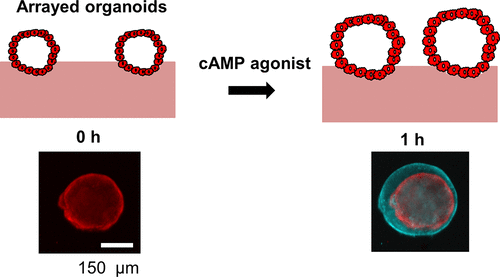当前位置:
X-MOL 学术
›
Anal. Chem.
›
论文详情
Our official English website, www.x-mol.net, welcomes your
feedback! (Note: you will need to create a separate account there.)
Development of Arrayed Colonic Organoids for Screening of Secretagogues Associated with Enterotoxins
Analytical Chemistry ( IF 6.7 ) Pub Date : 2018-01-12 00:00:00 , DOI: 10.1021/acs.analchem.7b04032 Dulan B Gunasekara , Matthew DiSalvo 1 , Yuli Wang , Daniel L Nguyen , Mark I Reed , Jennifer Speer , Christopher E Sims , Scott T Magness 1 , Nancy L Allbritton 1
Analytical Chemistry ( IF 6.7 ) Pub Date : 2018-01-12 00:00:00 , DOI: 10.1021/acs.analchem.7b04032 Dulan B Gunasekara , Matthew DiSalvo 1 , Yuli Wang , Daniel L Nguyen , Mark I Reed , Jennifer Speer , Christopher E Sims , Scott T Magness 1 , Nancy L Allbritton 1
Affiliation

|
Enterotoxins increase intestinal fluid secretion through modulation of ion channels as well as activation of the enteric nervous and immune systems. Colonic organoids, also known as colonoids, are functionally and phenotypically similar to in vivo colonic epithelium and have been used to study intestinal ion transport and subsequent water flux in physiology and disease models. In conventional cultures, organoids exist as spheroids embedded within a hydrogel patty of extracellular matrix, and they form at multiple depths, impairing efficient imaging necessary to capture data from statistically relevant sample sizes. To overcome these limitations, an analytical platform with colonic organoids localized to the planar surface of a hydrogel layer was developed. The arrays of densely packed colonoids (140 μm average diameter, 4 colonoids/mm2) were generated in a 96-well plate, enabling assay of the response of hundreds of organoids so that organoid subpopulations with distinct behaviors were identifiable. Organoid cell types, monolayer polarity, and growth were similar to those embedded in hydrogel. An automated imaging and analysis platform efficiently tracked over time swelling due to forskolin and fluid movement across the cell monolayer stimulated by cholera toxin. The platform was used to screen compounds associated with the enteric nervous and immune systems for their effect on fluid movement across epithelial cells. Prostaglandin E2 promoted increased water flux in a subset of organoids that resulted in organoid swelling, confirming a role for this inflammatory mediator in diarrheal conditions but also illustrating organoid differences in response to an identical stimulus. By allowing sampling of a large number of organoids, the arrayed organoid platform permits identification of organoid subpopulations intermixed within a larger group of nonresponding organoids. This technique will enable automated, large-scale screening of the impact of drugs, toxins, and other compounds on colonic physiology.
中文翻译:

开发用于筛选与肠毒素相关的促分泌素的阵列结肠类器官
肠毒素通过调节离子通道以及激活肠神经和免疫系统来增加肠液分泌。结肠类器官,也称为类结肠,在功能和表型上与体内结肠上皮相似,已被用于研究生理学和疾病模型中肠道离子转运和随后的水通量。在传统培养物中,类器官以球体形式存在,嵌入细胞外基质的水凝胶饼中,并且它们在多个深度形成,损害了从统计相关的样本量中捕获数据所必需的有效成像。为了克服这些限制,开发了一种将结肠类器官定位于水凝胶层平面的分析平台。在 96 孔板中生成密集的类器官阵列(平均直径 140 μm,4 个类器官/mm 2 ),从而能够分析数百个类器官的反应,从而可识别具有不同行为的类器官亚群。类器官细胞类型、单层极性和生长与嵌入水凝胶中的相似。自动成像和分析平台有效地跟踪了由于毛喉素和霍乱毒素刺激的细胞单层中的液体运动引起的随时间的肿胀。该平台用于筛选与肠神经和免疫系统相关的化合物,了解它们对上皮细胞液体运动的影响。前列腺素 E2 促进部分类器官中水通量的增加,从而导致类器官肿胀,证实了这种炎症介质在腹泻中的作用,但也说明了类器官对相同刺激的反应存在差异。 通过允许对大量类器官进行采样,阵列类器官平台可以识别混合在较大组无反应类器官中的类器官亚群。该技术将能够自动、大规模地筛选药物、毒素和其他化合物对结肠生理学的影响。
更新日期:2018-01-12
中文翻译:

开发用于筛选与肠毒素相关的促分泌素的阵列结肠类器官
肠毒素通过调节离子通道以及激活肠神经和免疫系统来增加肠液分泌。结肠类器官,也称为类结肠,在功能和表型上与体内结肠上皮相似,已被用于研究生理学和疾病模型中肠道离子转运和随后的水通量。在传统培养物中,类器官以球体形式存在,嵌入细胞外基质的水凝胶饼中,并且它们在多个深度形成,损害了从统计相关的样本量中捕获数据所必需的有效成像。为了克服这些限制,开发了一种将结肠类器官定位于水凝胶层平面的分析平台。在 96 孔板中生成密集的类器官阵列(平均直径 140 μm,4 个类器官/mm 2 ),从而能够分析数百个类器官的反应,从而可识别具有不同行为的类器官亚群。类器官细胞类型、单层极性和生长与嵌入水凝胶中的相似。自动成像和分析平台有效地跟踪了由于毛喉素和霍乱毒素刺激的细胞单层中的液体运动引起的随时间的肿胀。该平台用于筛选与肠神经和免疫系统相关的化合物,了解它们对上皮细胞液体运动的影响。前列腺素 E2 促进部分类器官中水通量的增加,从而导致类器官肿胀,证实了这种炎症介质在腹泻中的作用,但也说明了类器官对相同刺激的反应存在差异。 通过允许对大量类器官进行采样,阵列类器官平台可以识别混合在较大组无反应类器官中的类器官亚群。该技术将能够自动、大规模地筛选药物、毒素和其他化合物对结肠生理学的影响。











































 京公网安备 11010802027423号
京公网安备 11010802027423号